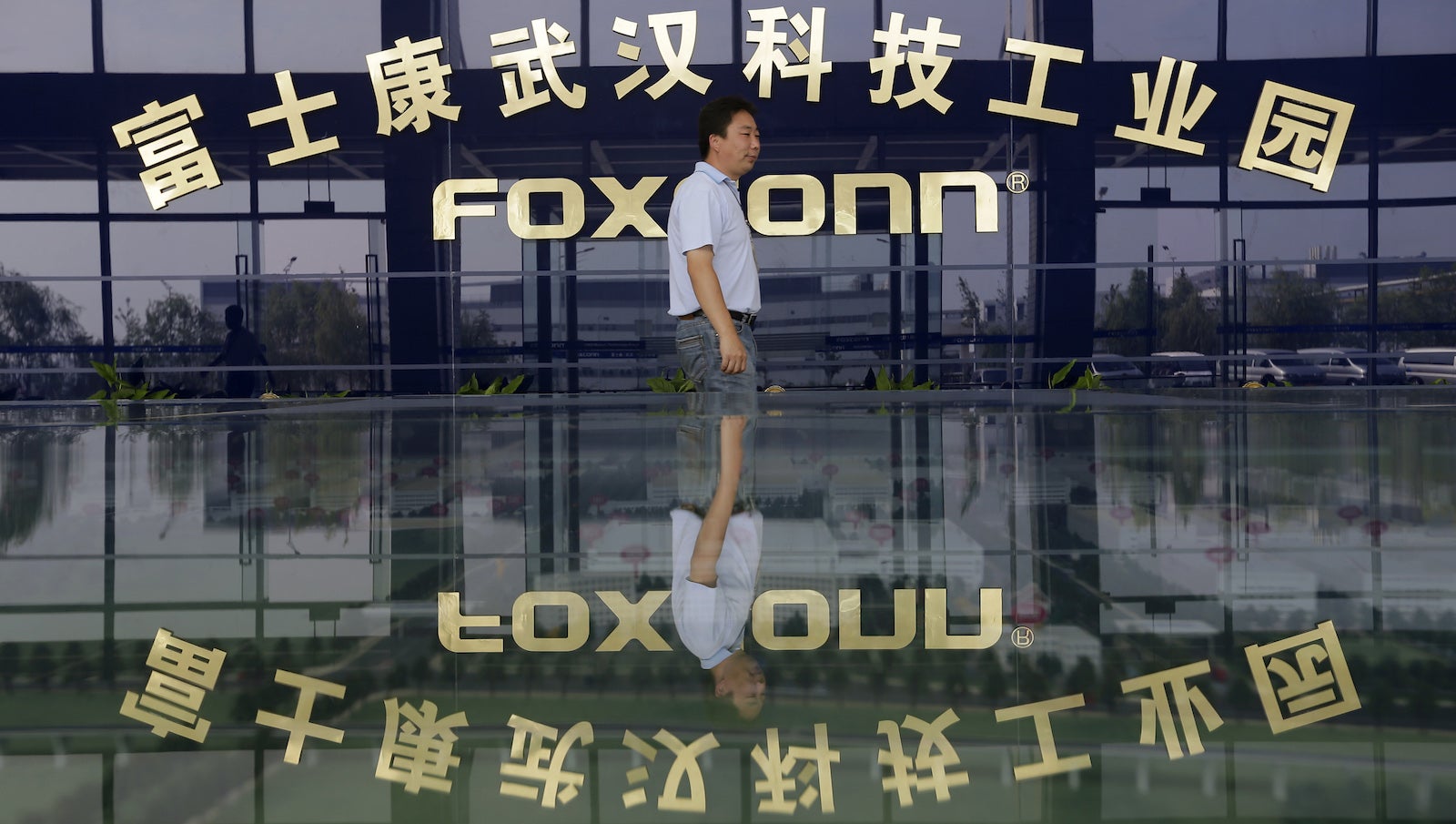Timeline: Foxconn is back in India with a $5 billion big bang investment
This post has been updated.


This post has been updated.
Six months after it shut down operations in India, Foxconn is all set to re-enter Asia’s third largest economy.
On Aug. 8, the Taiwan-headquartered Foxconn said it will invest $5 billion (Rs31,900 crore) in India over five years to set up an electronics manufacturing unit in the western state of Maharashtra.
The investment will create 50,000 jobs in the country, Maharashtra chief minister Devendra Fadnavis said.
Foxconn will undertake manufacturing, research and development at the new facility, the company’s chairman Terry Gou said while making the announcement.
The unit, proposed to be spread across 1,500 acres, will be situated between Mumbai and Pune.
Foxconn makes popular devices such as iPhone, BlackBerry, Kindle and PlayStation in its facilities in China, where the contract manufacturing firm has even admitted to violating labour norms in 2013.
Earlier this week, Gou had also said he was looking at setting up manufacturing units in various Indian states and possible partnerships in the world’s fastest growing smartphone market.
“We are looking at a 10-year plan but there are too many barriers to overcome,” Gou said. “We are looking at India for the long term.”
Reports had earlier suggested that the Taiwanese electronic manufacturer may look to partner with Japan’s SoftBank to set up a mobile components manufacturing unit in India. “The details are still work in progress. The announcement will be made in association with Foxconn later,” Masayoshi Son, SoftBank’s chairman and chief executive office, said on June 22.
Here’s the timeline of Foxconn’s struggles in India:
April 2006: Foxconn enters India, mainly to manufacture for Nokia, an important client at that time. The company sets up facilities in and around Chennai in the south Indian state of Tamil Nadu. FIH Mobile Limited, a subsidiary of Foxconn, establishes three facilities—two at Sriperumbudur and one at Sunguvarchatram.
July 2010: Foxconn is forced to temporarily shut its factory in Sunguvarchatram after 250 workers are hospitalised. The workers, who make mobile phone components, had experienced “sensations of giddiness and nausea,” according to the company. This may have been caused by “routine spraying of pesticide,” the company said in a filing to the Hong Kong bourse. Operations resume a month later.
October 2010: A group of workers—319 by some estimates—at Foxconn’s Sriperumbudur unit are arrested for breaching labour laws by going on strike during the cooling-off period, a recess in negotiations. Around the same time, a labour activist group—Students and Scholars Against Corporate Misbehaviour—alleges that Foxconn’s Indian workers are paid around $106 (Rs4,470) per month, about a third of what the company’s employees at its southern China factories receive.
February 2011: Nokia clinches a deal with Microsoft to jointly develop a product to rival the iPhone. However, Google’s Android platform starts making inroads into the highly competitive smartphone market. And as competition between Android and Apple steps up, Windows loses out.
September 2011: Finnwatch, a Finnish NGO focusing on corporate responsibility, publishes a report on working conditions at mobile phone factories in India. “During focus group sessions, Foxconn workers complained about health issues and the medical facilities available to them,” Finnwatch says in its report (pdf). “They reported that there have been no health check-ups since they started work, and that the health centre has only an un-trained nurse who gives them the same pill regardless of the symptoms they complain about.”
April 2014: Microsoft buys out Nokia, Foxconn’s single largest client in India.
December 2014: Foxconn announces plans to shut down its India operations because of dwindling orders. “We can confirm that our India operation, FIH India Private Limited, will be suspending all operations at our manufacturing facility in Chennai effective December 24, 2014,” Foxconn says. “This action is being taken due to a change in that facility’s customer base and a related change in the manufacturing requirements of our customers in India.”
February 2015: After several weeks of negotiations with employees, who were agitating against the suspension of operations at the Sriperumbudur plant, Foxconn agrees to a severance deal. “A settlement for severance was concluded with employee representatives on February 12, 2015 and based on that agreement, the last day of employment for all employees of FIH India Private Ltd was February 10,” Foxconn says.
According to the severance package, the salary payable by the company is increased from 12 months to 15 months—the previous offer was that the workers would get two months salary for every year of service with a cap of 12 months. And the compensation amount increased from Rs50,000 ($786) to Rs1 lakh ($1572). The company also fixes a cap on the maximum pay out for each employee at Rs4.80 lakh ($7,548), from the previously offered Rs3.25 lakh ($5,110).
May 2015: Foxconn chairman Terry Gou says the company is aiming to develop 10-12 facilities in India, including factories and data centres, by 2020.
June 2015: SoftBank’s Son announces that his company and Foxconn are in discussion to set up a joint venture in India for manufacturing telecom products.
August 2015: Foxconn says it will invest $5 billion over five years to set up an electronics manufacturing unit in Maharashtra. The company will undertake both research and manufacturing at the new unit. The investment will create 50,000 jobs in the country.